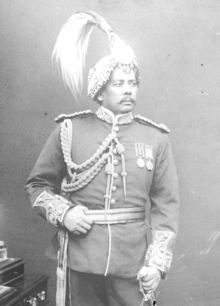Dhir Shumsher Rana | |
|---|---|
| धीर शम्शेर कुँवर राणा | |
 Commander-In-Chief of the Nepalese Army Dhir Shumsher Kunwar Ranaji (1828–1884) | |
| Commander-In-Chief of the Nepalese Army | |
| In office 11 May 1879 – 14 October 1884 | |
| Monarchs | Surendra of Nepal Prithvi Bir Bikram Shah |
| Preceded by | Jagat Shumsher Rana |
| Succeeded by | Jit Jung Rana |
| Personal details | |
| Born | c. 1828 |
| Died | 14 October 1884 Kathmandu, Kingdom of Nepal |
| Spouse(s) | Nanda Kumari Thapa (third wife) Juhar Kumari Devi (fifth wife) |
| Children | see below |
| Parents |
|
| Relatives | see Kunwar family; see Rana dynasty; see Thapa dynasty; see Pande dynasty |
| Military service | |
| Allegiance | |
| Battles/wars | Nepalese-Tibetan War, Indian Mutiny of 1857 |
Dhir Shumsher Kunwar (1828 – 1884 Kathmandu), after 1848 known as Dhir Shumsher Kunwar Ranaji [1][2] (Nepali: धीर शम्शेर कुँवर राणाजी) or Dhir Shumsher Jang Kunwar Ranaji[3] or shortly Dhir Shumsher Rana[4] posthumously known as Dhir Shumsher Jang Bahadur Rana, was a Nepalese politician, army general, and minister of state. He served as the Commander-In-Chief of the Nepalese Army from 1879 to 1884.
He was born in Kunwar family as the youngest son of Kaji Bal Narsingh Kunwar and Ganesh Kumari Thapa, daughter of Kaji Nain Singh Thapa of Thapa dynasty. Dhir Shumsher was the youngest brother of Jang Bahadur Kunwar Ranaji, who rose to premiership of Nepal after the murders of influential persons – Mathabarsingh Thapa and Gagan Singh Bhandari and the Kot Massacre. Dhir was personally involved in the massacre, protecting his nearly slaughtered brother Krishna Bahadur Kunwar Rana. Dhir became military colonel after the incident. He was in the entourage of Jung Bahadur's visit of Europe in the early 1850s.
Dhir Shumsher led the Nepalese Army in the two victorious campaigns i.e. Nepalese-Tibetan War in 1855–1856 and in the Indian Mutiny of 1857. He consolidated greater power when his elder brother Commander-in-Chief Jagat Shamsher Kunwar Rana died in 1879. Onwards, he became the Commander-In-Chief of the Nepalese Army and was the stronghold behind the premiership of Shri Tin Maharaja Ranodip Singh Bahadur Kunwar Rana. He protected the premiership of his brother from a coup attempt by Jagat Jung Rana, eldest son of Jang Bahadur and Crown Prince Trailokya of Nepal in 1881–82 known as "38 Saalko Parva". His presence prevented the clash of his 17 sons against the sons of Jung Bahadur. His death in 1884 paved way for the consolidation of power by his 17 sons (Shamsher Ranas) through the murder of Premier Ranodip Singh Kunwar.
- ^ Tribhuvan University 1978, p. 2.
- ^ Hutchins, Francis G. (2007). Democratizing monarch: a memoir of Nepal's King Birendra. Vajra Publications. ISBN 9789994678846.
- ^ Rose 1971, p. 120.
- ^ Cite error: The named reference
PurushottamShamsher1998was invoked but never defined (see the help page).